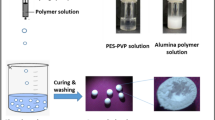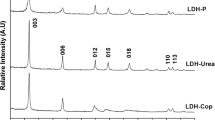Abstract
The physical and mathematical models were used to study the method of acid retardation for separating acids from their salts in concentrated multicomponent solutions using nanoporous sorption materials. A combined mechanism of separation relies on the fact that in the sorption phase having a low dielectric permittivity, smaller-sized acid particles, namely, the molecules or strongly bound and weakly hydrated ion pairs, can penetrate the nanopores and are retained within these pores due to molecular sorption or competitive solvation forces. The dissolved salts presented by highly hydrated ions or weakly bound ion pairs can easily pass through the porous medium with a flow of concentrated solution, which is pumped through the column packed with the granulated bed of gel-type ion exchange resins or hypercrosslinked polymers. In conventional cyclic AR processes, purified acid is desorbed by water according to the mechanism of competitive solvation. However, such processes can be successfully used only when the salts separated from acids are highly soluble, as is the case with chloride and nitrate solutions free of components that may form compounds insoluble in neutral medium. At the separation in real sulfate and phosphate media, which normally contain alkaline earth metals and other components, conventional AR- based technologies proved to be unsuccessful. The new modified version of acid retardation is based on the previously discovered effect of stabilization of colloidal systems and supersaturated solutions in porous ion exchange media. A distinctive feature of the proposed technique is the use of weakly acidic aqueous solutions, instead of water, at the stages of acid displace in the cyclic AR processes. The proposed technique of WPA purification using strong-base gel-type ion exchangers in the phosphate form opens up the possibility of stable and feasible processes of acid separation and purification with simultaneous extraction of valuable components, e.g., REE concentrate.
Similar content being viewed by others
References
A Reference Book of Chemist. Six Volumes, Ed. by B. P. Nikol’skii (Khimiya, Moscow, 1963) [in Russian], Vol. 1, pp. 948–958.
A Reference Book of Chemist. Six Volumes, Ed. by B. P. Nikol’skii (Khimiya, Moscow–Leningrad, 1964), Vol. 3, pp. 78–114.
A. A. Bolotokov, M. A. Kumakhov, A. N. Gruzdeva, and R. Kh. Khamizov, “Possibilities of micro X–ray fluorescence spectrometry of solutions with preconcentration,” J. Anal. Chem. 69 (8), 728–734 (2014).
V. A. Davankov, M. P. Tsyurupa, and N. N. Alexienko, “Selectivity in preparative separations of inorganic electrolytes by size–exclusion chromatography on hypercrosslinked polystyrene and microporous carbons,” J. Chromatogr. A 1100 (1), 32–39 (2005).
V. M. Davankov, Z. Blinnikova, and L. Pavlova, “Self–concentration effects in preparative SEC of mineral electrolytes using nanoporous neutral polymeric sorbents,” J. Sep. Sci. 32 (1), 64–73 (2009).
N. B. Ferapontov, L. R. Parbuzina, V. I. Gorshkov, N. L. Strusovskaya, and A. N. Gagarin, “Interaction of cross–linked polyelectrolytes with solutions of low–molecular–weight electrolytes,” React. Funct. Polym. 45, 145–153 (2000).
E. A. Glotova, N. A. Tikhonov, R. K. Khamizov, and A. N. Krachak, “Mathematical modeling of a sorption process for the retention of acid from a solution,” Moscow Univ. Phys. Bull. 68 (1), 65–70 (2013).
M. J. Hatch and J. A. Dillon, “Acid retardation. A simple physical method of separation of strong acids from their salts,” I&EC Process Design and Development 2 (4), 253–263 (1963).
F. G. Helfferich, “The theory of precipitation/dissolution waves,” AIChE J. 35 (1), 75–87 (1989).
R. Kh. Khamizov, B. F. Myasoedov, B. A. Rudenko, and N. A. Tikhonov, “General character of isothermal supersaturation in ion exchange,” Dokl. Phys. Chem. 356(1–3), 310–314 (1997).
P. S. Kindyakov, V. E. Plyushchev, S. B. Stepina, P. I. Fedorov, et al., Chemistry and Technology of Rare and Trace Elements. Volume 2. Technology of Rare and Trace Elements, Ed. By L. A. Bol’shakov (Vysshaya Shkola, Moscow, 1969) [in Russian].
Yu. A. Kokotov, and V. A. Pasechnik, Ion Exchange Equilibrium and Kineticts (Khimiya, Leningrad, 1970) [in Russian].
A. N. Krachak, R. Kh. Khamizov, V. A. Poznukhova, E. B. Podgornaya, and V. A. Durnaykin, “Basic regularities of electrolyte separation in the method of Acid Retardation. I. Influence of cation type on the sorption of acids and their salts from binary solutions,” Sorption Chromatogr. Proc. 11 (1), 77–88 (2011)
A. K. Lyashchenko and I. M. Karataeva, “The activity of water and permittivity of aqueous solutions of electrolytes,” R. J Phys. Chem. A. 84 (2), 320–328 (2010).
D. N. Muraviev and R. Kh. Khamizov, “Ion exchange isothermal supersaturation. concept, problems and application,” Ion Exch. Solvent Extr. Ser. Adv. 16, 119–210 (2004).
D. Muraviev, R. Kh. Khamizov, and N. A. Tikhonov, “Pecularities of the dynamics of ion exchange in supersaturated solutions and colloid systems,” Langmuir 19, 10852–10856 (2003).
R. A. Robinson and R. H Stokes, Electrolyte Solutions (Butterworth and Co, London, 1970).
G. B. Sidelnikov, N. A. Tikhonov, R. Kh. Khamizov, and A. N. Krachak “Modeling and study of sorption and separation of acids in solution,” Math. Models Comp. Simul. 5 (6), 501–510 (2013)
N. A. Tikhonov, V. V. Kirshin, and R. Kh. Khamizov, “Description of ion–exchange dynamics at an isothermal supersaturation in the presence of colloid particles on the surface of sorbent granules,” Russ. J. Phys. Chem. A. 74 (2), 246–252 (2000).
N. A. Tikhonov, “A new approach to calculating activity coefficients in a wide range of electrolyte concentration,” Dokl. Math. 82 (2), 808–810 (2010).
N. A. Tikhonov and G. B. Sidelnikov, “Quantitative analysis of physical factors that determine the behavior of activity coefficients of electrolytes,” J. Math. Chem. 51 (10), 2746–2756 (2013).
N. A. Tikhonov and G. B. Sidelnikov, “Modeling of physical effects governing the behavior of the activity coefficients of an electrolyte,” Math. Models Comp. Simul. 7 (1), 6–12 (2015).
N. A. Tikhonov and M. G. Tokmachev, “Quantitative analysis of physical factors that determine activity coefficients of electrolytes. III. Mixtures of electrolytes,” J. Math. Chem. 54 (2), 592–601 (2016).
Author information
Authors and Affiliations
Corresponding author
Rights and permissions
About this article
Cite this article
Khamizov, R.K., Tikhonov, N.A., Krachak, A.N. et al. Separation of concentrated acid and salt solutions in nanoporous media as the basis for a new technology of processing of phosphorus-containing raw materials. Geochem. Int. 54, 1221–1235 (2016). https://doi.org/10.1134/S0016702916130085
Received:
Accepted:
Published:
Issue Date:
DOI: https://doi.org/10.1134/S0016702916130085




